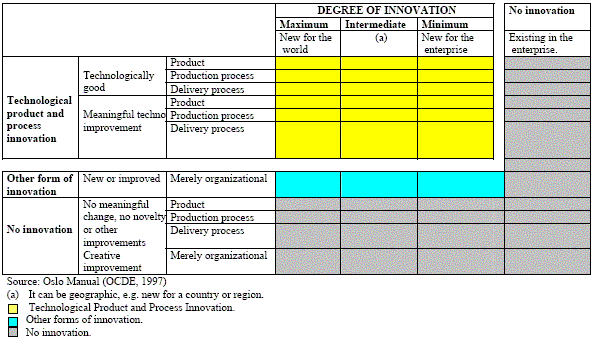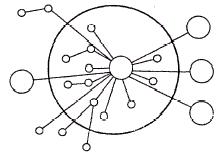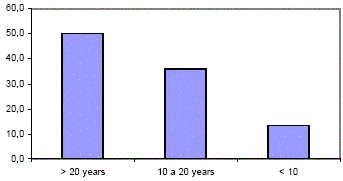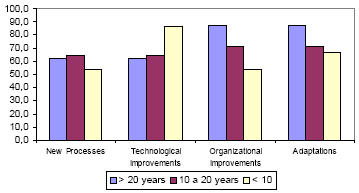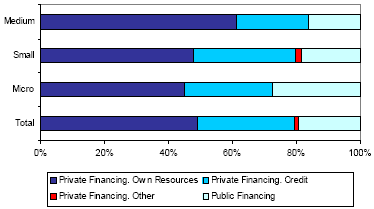|
Artículo |
||||||||||||||||||||||||||||||||||||||||||||||||||||||||||||||||||||||||||||||||||||||||||||||||||||||||||||||||||||||||||||||||||||||||||||||||||||||||||||||||||||||||||||||||||||||||||||||||||||||||||||||||||||||||||||||||||||||||||||||||||||||||||||||||||||||||||||||||
|
Small and medium enterprise innovation
ABSTRACT The aim of this study is to analyze the innovative potential of small and medium enterprises (SMEs) in the Region of Antofagasta. The results of a questionnaire applied to 50 SMEs considered as innovative according to OCDE criteria show a contradictory situation: there is an increasing awareness of the importance of innovation in the region while many obstacles to innovate are recognized. This constrains can affect negatively the project of creating an industrial and service cluster around mining in the region.
INTRODUCTION Small and Medium Enterprises (SMEs), despite their financial, organizational and technological constrains, can be regarded as one of the most relevant agents in regional innovation processes (OCDE, 2003a; and Alfonso, 2002). SMEs´ innovation is heterogeneous and its traits heavily depend on each region history and characteristics. The aim of this work is to analyze the SMEs´ innovative potential in the Region of Antofagasta (Chile). That is, to evaluate local SMEs´ capacity to create or modify products or processes and to introduce them in the market. There are two reasons that support the analysis of SMEs’ innovation processes in the Region of Antofagasta. On the one hand, studies that allow the identification of key factors for competitivity and regional endogenous development are still scarce in Chile; on the other hand, the characterization of SMEs´ innovation practices is essential for the proposal and application of policies aiming to reduce SMEs´ constraints and to facilitate the establishment of regional networks for innovative enterprises. This focus on policy application is particularly important in the Region of Antofagasta because a program for creating a mining cluster is being implemented since 2002, one of whose main goals is to promote local innovation. Section one presents a detailed bibliographic revision on innovation and the characteristics of SMEs´ innovation processes. Section two describes the methodology of the study, which has been based on a structured survey designed according to the criteria of innovation polls used by INE (Chile) and OCDE in Oslo (1997) and Frascati (2003b) Manuals. The study sample was selected from databases provided by institutions such as CORFO (Corporation for Fostering Production) through FONTEC, CDP (Corporation for Productive Development) and AIA (Antofagasta Industrial Association). After analyzing these databases, 50 enterprises were selected for the study. The survey was directed to enterprise managers, 37 of which responded: 7 micro-enterprises, 22 small enterprises and 8 medium enterprises from different areas, mainly general and industrial service companies. Finally, section three shows and analyzes questionnaire results and comes to some conclusions regarding their policy implications. 1. THEORETICAL AND CONCEPTUAL FRAMEWORK 1.1. Knowledge as a basis for innovation Schumpeter seminal work (1934) analyzed how entrepreneurs’ innovations lead to technological change and, consequently, to the creation of knowledge. The so-called “promoter entrepreneur” is motivated to take the risk of introducing new ideas in the market due to the monopoly profits he eventually expects for being the first to enter the market. Technological changes introduced by entrepreneurs cause a productivity increase and, in the long run, create opportunities for future investments in other entrepreneurs’ productive capacity. From this perspective, knowledge incorporated into technology will eventually lead to a greater growth. Thus, technology is likely to play a fundamental role in present knowledge-based economy. Nowadays, expressions like “society of knowledge” and “knowledge economy” are widely used to describe the trend of more advanced economies to a greater use of knowledge as a development factor. This tendency has been closely related to the technological advances produced by information revolution, to transport cost reduction and to the emergence of an increasingly global economic and social space. Knowledge in its various forms plays an essential role in economic behavior (OECD, 1996). From a microeconomic perspective, individuals with greater capacity to manage information and change it into knowledge will have indeed greater possibilities of a better life, and companies able to manage and systematically use knowledge will have more possibilities to compete in global markets, adapt to changes, and get more benefits. At the same time, from a macroeconomic perspective, countries and regions effectively developing and managing their knowledge as assets will reach greater development and growth. The recent recognition of knowledge as a strategic productive factor explains the increase investment in research and development, education, training and other intangibles. In fact, most countries have given increasing importance to these types of investments against physical ones, having the conviction that knowledge applied to technology is the key for development. 1.2. Concepts and types of innovations. Schumpeter (1934) defines innovation as "The result of establishing a new production function, a change in the set of possibilities to define what a product is and how it could be. This definition does not necessarily involve the introduction of a new element or novelty in the economic process, but it focuses on technological changes – understood as the way of combining different productive factors – that allow an increase the frontier of production possibilities in an economy. From this definition, Schumpeter put forward a classification that includes five forms of innovation, whose basic aspects are still used:
The first two categories of this classification are currently used to assess science and technology policies. In fact, OECD Oslo Manual (1997) call them "technological product and process innovations". Another classification extensively found in related economic literature is the one that distinguishes between radical and incremental innovations (Vázquez-Barquero, 1999):
Undoubtedly, both types of innovations, radical and incremental, are closely related since incremental innovations involve improvement of radical innovations, and, sometimes, can have more economic importance than initial radical innovation, whose potential application may not be known thoroughly. There are several classifications of innovation which reveal different aspects of innovative processes and reflect their complexity. This work used the classification proposed by OCDE in its Oslo Manual (1997), where a distinction is made between product and process innovations: "Technological product and process innovations comprise new technologically implemented products and processes and meaningful technological product and process improvements." "A technological product and process improvement has been implemented if it has been introduced in the market (product innovation) or used in a productive process (process innovation). Technological product and process innovations involve a series of scientific, technological, organizational, financial, and commercial activities. The enterprise technologically innovating in product and process is that which has technologically implemented new or meaningful product or process improvements during the period under study.” “In this case, the product or process should be new or meaningfully improved for the enterprise (it does not have to be new for the world).” Among the main components of technological innovations are, therefore, products and processes according to the extent of novelty that has been introduced in each case. a) Technological product(1)innovation can take two forms:
b) Technological process innovation consists in adopting technologically new or improved production methods, including product delivery methods. These methods may involve changes in equipment, production organization, a combination of both, or can be due to the application of new knowledge. These processes may be used to produce or provide technologically new or improved products which cannot be produced or provided by conventional production methods, or essentially, to increase efficient production or provision of existing products. c) Technological product and process innovation must be distinguished from organizational innovation and other product or process changes:
1.3. The innovation process. Schumpeter’s contribution (1934) mainly focused on radical innovations introduced by promoter entrepreneurs who generate big discontinuities in the productive system in order to get monopoly profits and, with them, promote economic growth in imperfect competition situations. From this perspective, other activities connected to technological change were considered less important. Invention was regarded as exogenous to the productive system, that is, externally provided by scientific research and knowledge. In his latest work, Schumpeter (1943) advances toward a more nuanced position in which the endogenous character of a big portion of technological improvements and inventions was recognized. This perspective makes incremental innovations more important for enterprise development since innovation is regarded as a continuous process, endogenous to productive network and able to spread by continuous improvement (Vázquez Barquero, 1999). During the XX century, scholars have tried to give light to the way in which innovation is generated in the enterprise and how this is influenced by internal and external factors. The main models used to describe the innovation process have evolved toward increasingly wider and more complex explanations of the way enterprises innovate. Initially the “lineal model”, also known as “Science Push”, puts emphasis on scientific knowledge supply as a basis for innovation and economic performance. According to the hypothesis of this model, a lineal process leads to innovation in progressive stages. First, knowledge is discovered in universities and research centers; spreads towards enterprises through publications, patents, and other forms of scientific dissemination and, lastly, arrives to the final consumer in the form either of products or services. Unlike the lineal model where innovations come from science, the “Demand pull” model establishes that the origin of innovation lies in market demand. According to this assumption, consumer demand variations reflected in investment rates have a direct impact on the number of patents, that is, patented innovation creation is an economic activity of the market subjected to demand behavior (Schmookler, 1966). Since the 1970s, several studies began to show the excessive simplicity of lineal and “demand pull” models. Among alternative proposals, the so-called “Chain-Link model” stands out. This model, developed by Kline and Rosenberg (1986: 289-291), was adopted by OECD in the report from the Technology/Economics Program (TEP, OCDE, 1996a) and used as a conceptual framework in the Oslo Manual (OCDE, 1996b) for measuring technological innovation. The model conceptualizes innovation in terms of the interaction among market opportunities, knowledge basis and enterprise abilities. In this sense, it contains and surpasses lineal and “demand pull” innovation models. Kline and Rosenberg propose the existence of innovation stages in the enterprise and relate them to the innovation system where the firm is involved. Each of these stages involves a number of sub processes. Therefore, there is no continuous and lineal progression in the process of innovation, and it is frequently necessary to return to initial stages to overcome difficulties. All this implies feedback among the different parts of the process and an endogeneization of the innovation process. The “Chain-Link model” has advanced toward increasingly complex proposals establishing high levels of functional integration in the innovation process. In this respect, Rothwell (1994) proposes the creation of the so-called “fifth-generation” models or “System Integration Network” (SIN) models, which emphasize the importance of transferring and spreading ideas, abilities, knowledge, information, and various types of signals. In these models the channels and networks through which information, knowledge, and innovation flow and disseminate are embedded in cultural, political and social environment and strongly driven by institutional structures. More recent theories about innovation processes integrate the economic perspective of technological change with sociological, psychological and knowledge theories that focus on learning as the fundamental basis of innovation. From this perspective, both learning and innovation are interactive processes linked to productive and social networks. In this respect, Vázquez Barquero (1999) states that the innovation process is a social phenomenon, that is, a process stimulated through cooperation between local actors and specific territory endowments. In this sense, Asheim and Isaksen (1998) state that innovation processes are based on cooperation between the enterprises and institutions that make up the productive, social and institutional network of a territory. From this view, innovation is basically a learning process. The social and territorial dimension of innovation implies the creation of knowledge transcends enterprise and actors’ individuality and become a collective learning process through territorial interactions. One of the most interesting traits of innovation conceived as a social process is its close relation to space. Innovation takes place in a specific territory and its characteristics make innovation more or less probable. In this sense, it is common to speak of “innovative regions” or “millieux innovateurs” as those territories having a productive and institutional framework that makes the region competitive due to its innovation capacity. This view of innovation has been one of the arguments that have led countries to a progressive regionalization of innovation policies. 1.4. SMEs in the Region of Antofagasta. According to Markusen’s typology (1996), figure1.2, the territorial organization of production in the Region of Antofagasta is close to be a “Hub-and Spoke District”, where a network of service and industrial SMEs (spokes) works around large mining companies (hubs)(2), mainly from abroad, that subcontract specialized services for different stages of the value chain.
Culverwell (2002) states that, in 2001, large mining enterprises bought 51.6% of their intermediate products and services in the Region while the rest was purchased in other Chilean regions or abroad. Large companies did 40% of their purchases to subcontractors; 30% to electricity, gas and water enterprises and the remaining 30% to industry and other activities related to commerce, lodging, food and transport. All these activities represent about 90% of firms in the region, 90% of which are SMEs. Large mining enterprises contracts tend to be in the short term (3 to 10 months), except in the case of electricity, gas, water, and transport enterprises (31% of the total), activities where medium and large enterprises are predominant. Thus, about 70% of products and services purchased in the region by large mining enterprises come from microenterprises and SMEs (Culverwell, 2002). Taking into account the strong mining specialization of the Region of Antofagasta (more than 60% of its GNP comes from this activity), CORFO has proposed an Integrated Territorial Program (PTI) in order to create an industrial and service productive cluster around mining, whose execution period will be 2003 to 2006. PTI considers SMEs as key actors for creating the mining cluster and also accepts the limitations and obstacles these enterprises face in the region, recognizing that "The relationship between regional large mining industry and SMEs has not been able to generate the necessary chain to allow developing a sustainable entrepreneurial basis in the long run, with adequate profits for the region" (CORFO, 2003). The Region of Antofagasta represents 2.9% of Chilean SMEs. This percentage is lower than the region weight in terms of both population and product. However, during the second half of the 1990, regional SMEs growth has been greater than in the rest of the country s and has been characterized by high enterprise birth and death rates (Crespi, 2003). Activities involving a greater number of SMEs are commerce, transport and construction, while technical services and industry (food, metallic products, and machinery) rank in second and third place. According to Pyke’s classification (1994), the network of SMEs in the Region of Antofagasta is predominantly composed by “dependent contractors”. These are firms with reduced technological competence and subjected to asymmetric relationships with large mining enterprises which, in many cases, are their only customers. They produce parts on demand or provide services at medium or low specialization. So, they are under strong pricing pressure because they can be easily substituted by other subcontractors. In order to offer lower prices they follow a cost reduction strategy affecting work contract flexibility (seasonal contracts, extra hours or subcontracts with smaller companies) and the type of worker employed, commonly medium or low qualified. The formation of a mining cluster based on the conditions above described, close to a “Hub-and-Spoke District” and mainly related to dependent subcontracted enterprises poses difficulties for the creation of productive networks promoting management modernization and productive innovation, particularly in the case of SMEs:
2. METHODOLOGY 2.1 Sample Description. In order to analyze the innovative potential of SMEs in the Region of Antofagasta. recommendations from OECD, Oslo and Frascati Manuals, were considered to design an innovation and R&D survey in the entrepreneurial sector. Due to the lack of a reliable and detailed SMEs directory to estimate the universe to be analyzed, a non-random sample including SMEs that do or are supposed to do modernization and innovation activities was selected. To identify this type of SMEs, various specialized organizations were chosen in the Region of Antofagasta:
After crossing data of the three organizations in which many enterprises were repeated, a list of 53 regional enterprises characterized by innovation was prepared. The final sample consisted of 37 enterprises. Response rate was relatively high reaching almost 70%, though it was necessary to insist before having access to many enterprises and some surveys had to be given twice or eliminated owing to the low degree of response. In this respect, it was difficult to collect information related to turnover, export and profits. Of the 37 enterprises that responded the survey, 60% are small. Ranking second are medium enterprises with 21.6% and then micro enterprises with 19%. Undoubtedly, this distribution does not correspond with the regional enterprise universe, where the biggest group is that of micro enterprises. Nevertheless, its important to note that this is a non-random sampling and, so the possibilities of innovative activities for micro enterprises are more reduced than for bigger firms. (Table 2.1).
If type of activity and firm size (Table 2.2) are analyzed, 5 out of 7 micro enterprises provide services to industry and only 2 represent other industrial sectors. In the case of small enterprises, though types of activities are more diverse, still service enterprises both general and industrial predominate. The same is true for medium enterprises where 6 out of 8 belong to the service sector.
2.2 Data Collection Questionnaire. A close-ended questionnaire was prepared according to the criteria established by INE and Oslo and Frascati OCDE manuals. The questionnaire consisted of 12 questions beginning with general questions that allow identifying and classifying enterprises. The following part of the questionnaire dealt with different aspects of the innovation process such as types of innovation, origin of innovative ideas, execution of innovation activities, technical progress in equipment purchased, innovation obstacles and innovation financing, among others. A pilot questionnaire was given to 5 enterprises considered innovative. Results were used to revise the test, eliminating and correcting some questions to produce the final version. 3. RESULTS. 3.1. Product Innovation. A high percentage of enterprises reported product innovations in the last three years. These innovations mainly relate to technological improvement (78.4%) and adaptation of products existing in the market (67.6%). About 30% of enterprises surveyed reported introducing new products into the market (See table 3.1.). Compared to similar surveys, this figure is higher than that commonly reported. This may involve an overestimation of product innovation by regional micro enterprises and SMEs. In the case of new products, a clear relationship exists between enterprise age and innovation results reported: 50% of enterprises older than 20 years reported this type of innovation (See graph 3.1.). Conversely, no meaningful differences are observed when comparing firm according to the number of employees.
3.2. Process Innovation. Results reported for this type of innovation are also high (See table 3.2.) and mainly related to technological improvements (67.6%) and process organization improvements (73%). The introduction of new processes shows too high a result (59.5%). This leads to think that entrepreneurs may have considered equipment purchase a form of innovation.
Enterprises older than 20 years reported greater amounts of innovations related to organizational process improvements and adaptations; while younger enterprises reported greater technological improvements (See graph 3.2.). Medium enterprises reported the greatest percent of organizational process improvements and the smallest in other innovations of this type.
3.3. Other Innovations. More than 75% of the enterprises reported some type of innovation in organizational management. No differences in enterprise size are observed, though this form of innovation may exist mainly in those older than 10 years. Design innovations are reported by 54% and packing innovations by 42.3%. There are no big differences among different types of enterprises versus size and age. Regarding projects done or to be done to develop new products and processes, 27% reported unsuccessful projects between 2000 and 2002; while 32.4% are presently involved in projects. 3.4. Innovation Financing. Financing mechanisms used for innovation have been 80% private and 20% public. Main internal financing sources have been own funds representing about 50% of innovation expenses. Bank credits represent 30% of financing. Other forms of private financing such as issuing shares or providers’ and customers’ advance payment seem to play an irrelevant role in innovation financing (See graph 3.3.). Medium enterprises seem to be the least dependent on public and bank financing for innovation. More than 60% of their expenses are financed with own resources. Conversely, micro enterprises need help to finance their innovations in a greater percent (27.5%). Finally, small enterprises ask for funds in banks to finance innovation expenses, representing about a third of their total expenses (See graph 3.3.).
3.5. Innovation Obstacles. Among the obstacles regional SMEs face to innovate, financial difficulties stand out. Almost 60% of the enterprises report that the high cost of innovation is a very important obstacle and 54% consider the difficulty to get adequate financing very important (See table 3.3.). Other aspects related to innovation project financing, like long return periods and economic risks innovation involves, are less important. Conversely, more technical aspects related to innovation management are regarded as obstacles by most enterprises surveyed (See table 3.3.). Curiously, lack of qualified personnel is regarded as a quite or very important obstacle for less than 50% of the enterprises. It seems to be more difficult to find experienced than qualified personnel. This obstacle is regarded as quite or very important by 51.3% of the enterprises (See table 3.4.). Resistance to change is considered a quite or very important obstacle by 43.1% of the enterprises; while the need to reduce payroll as a result of innovation activities is reported by 21.6%. When considering other obstacles for innovation, lack of market information affects almost 46% of the enterprises and lack of technological information 41%. This percentage is similar to that of the difficulty for establishing cooperation with other enterprises or public institutions. The latter is considered a quite or very important innovation obstacle by more than 40% of the enterprises. Lastly, 43.2% reported few incentives for innovation and more than a quarter reported no innovation because it is not necessary (See table 3.5.). Due to SMEs heterogeneity, innovation obstacles vary in importance according to size. Thus, innovation cost is the greatest obstacle for medium enterprises, reported as quite or very important by 100%. These enterprises also find more difficulties in the control of innovation expenses and are the most affected by their long return period. Besides, they find more difficulties for cooperation, especially with public institutions, possibly because of the need of larger investment and because public innovation-supporting programs focus on smaller enterprises. Because of their greater number of workers, medium enterprises consider payroll reduction as a quite or very important for innovation, reporting 25%; while the rest of the sample gives it almost no importance to this obstacle. Qualified personnel are also important for 50% of these enterprises; while they seem to have less trouble to hire experienced personnel. Small enterprises have more difficulty to get financing. 63.7% of this group considers this factor as a quite or very important obstacle. They also have the greatest trouble to hire qualified personnel (59.1%) and experienced personnel (72.7%). This may be due to the fact that this group reported having less information on technology which is regarded as a quite or very important obstacle for innovation by 50%. Besides, small enterprises negatively stand out for lack of innovative culture. In fact, 45.5% considers that the lack of incentives greatly limits innovation and 36.3% considers that innovation is not necessary.
In the case of micro enterprises, there seems to be lack of knowledge about possible obstacles to innovate maybe because this group had the least possibilities to do it. Anyway, 57.1% reported that lack of knowledge about market affects innovative initiatives quite or very negatively, followed by technical risks with 50% and lack of incentives, a quite or very important obstacle for 43% of the sample. CONCLUSIONS Results show that SMEs in the Region of Antofagasta are rather highly concerned about innovation as a strategy to competition. Innovation percentages reported are high in products, processes and organization. These results are remarkable particularly on product and process adaptation and improvement. In some cases, however, these may be due to an overestimation of innovative activity by respondent entrepreneurs. In fact, data on new products and processes for the market are not realistic and could be covering lack of knowledge about market and state of technology, or rather involving too wide a concept of innovation. In this sense, little changes in services and products offered as well as machinery purchase may be considered as market novelties. Although innovative activities are done mainly within the enterprise, the main obstacle reported has to do with capacity and access to financing. Access to external public resources is limited, except for small enterprises and more than half innovation expenses are funded with own resources. Human capital, regarded as one of the main sources of innovation ideas, may not exist in the necessary amount within regional SMEs network. This problem mainly affects micro and small enterprises that may not have enough capacity to attract more highly trained workers. A particularly negative data is that at least a quarter of the sample considers that innovation is not necessary for their activity, or that they do not have incentives to innovate. This lack of innovative culture affects, above all, small and medium enterprises since they find more obstacles when accessing information on markets and available technology. As a conclusion, there is a regional SMEs network which seems to have an increasing awareness of the importance of innovation for competitiveness and regional development (except in the case of some micro and small enterprises). This situation is related by SMEs to the need of equipment renewal and acquisition of international quality certificates, though the need of more ambitious innovation is not that large. SMEs innovation possibilities in the Region of Antofagasta are closely related to the way they organize as a productive network. The existence of a “Hub-and-Spoke district” makes innovation to be regarded important by some enterprises even without having important links with other organizations. In this sense, lack of cooperation with enterprises having the same line of business and the scarce importance of universities and public institutions are remarkable. Several path of research open up out of results obtained. Among them, it is highly interesting to deepen on the type of innovations that may result from customer-provider interaction and try to discover the mechanisms to reach better SMEs integration with the regional productive network. If this does not occur, the strength of a possible mining cluster is highly improbable. REFERENCES Alfonso, J. (Coord.) (2002), Empresa e Innovación en la Unión Europea. Minerva American Journal of Sociology Ediciones, Madrid. Aroca, P. (2001), "Impacts and development in local economies based on mining: The case of the Chilean II region". Resources Policy, 27, 119-134. Aroca, P. (2002), "Impacto de la Minería en la II Región" in P. Meller (editor) (2002), Dilemas y Debates en torno al cobre, Dolmen Ediciones, Santiago de Chile. Asheim, B.; Coenen, L. y Stevenson-Henning (eds.) (2003), "Nordic SME and Regional Innovation Systems". Final Report. Department and Social and Economic Geography Lund University, Suecia. CORFO (2003), "Programa Territorial Integrado "Cluster Minero Región Antofagasta" Desarrollo de un complejo productivo industrial y de servicios entorno a la minería. CORFO. Mimeo. Santiago de Chile. Crespi, G. (2003), "PyME en Chile: Nace, crece y… muere: Análisis de su desarrollo en los últimos siete años". Mimeo. FUNDES. Santiago de Chile. Culverwell, M. (2002), "Foreign Direct Investment and Corporate Linkages with Local Suppliers: An Exploration of Backward Linkages in the Mining Industry in Chile". A Dissertation Submitted for the Degree of Doctor of Philosophy. University of Cambridge. Judge Institute of Management. INE (2000) Segunda Encuesta de Innovación Tecnológica en la Industria Manufacturera. Informe Final. Programa de Innovación Tecnológica. INE. Kline, y Rosemberg, R. (1986), "An Overview of Innovation". En Landau R. y Rosemberg, R. (Eds.) The positive sum strategy. Harnessing Technology for Economic Growth. National Academic Press, Washington D.C. pp. 289-291. Markusen, A. (1996), "Sticky places in slippery space: a typology of industrial districts". Economic. Geography. 72, 293-313. Markusen, A. (1999), "Fuzzy concepts, scanty evidence, policy distance: the case for rigour and policy relevance in critical regional studies". Regional Studies. Vol. 33.9, 869-884. Nelson, R. (1993), National Innovation Systems. Oxford University Press, Oxford. OCDE (1996), The OCDE Jobs Strategy – Technology, Productivity and Job Creation. OCDE, París. OCDE (1997), Manual de Oslo. La medición de las Actividades Científicas y Tecnológicas. Eurostat. Segunda Edición. París. OCDE (2003a), Estudios Económicos de la OCDE. Paris. OCDE (2003b), Manual de Frascati. Propuesta de Norma Práctica para Encuesta de Investigación y Desarrollo Experimental. FECYT, París. Pyke, F. (1994), "Small firms, technical services and inter-firm cooperation". Research Series 99. Ginebra, International Institute for Labour Studies. Rothwell, R. (1994), "Successful Industrial Innovation: Success Strategy Trends". En Dogson, M. y Rothswell R. (Eds.), The Handbook of Industrial Innovation. Edward Elgar, Aldershot. Schmookler, J. (1966), Invention and Economic Growth. Harvard University Press, Cambridge. Schumpeter, J. (1934), The Theory of Economic Development. Orford University Press, Oxford. Schumpeter, J. (1943), Capitalism, Socialism and Democracy. Harper and Row, Nueva York. Vázquez Barquero, A. (1999), Desarrollo, Redes e Innovación. Lecciones sobre Desarrollo Endógeno. Ed. Pirámide, Madrid.
|
||||||||||||||||||||||||||||||||||||||||||||||||||||||||||||||||||||||||||||||||||||||||||||||||||||||||||||||||||||||||||||||||||||||||||||||||||||||||||||||||||||||||||||||||||||||||||||||||||||||||||||||||||||||||||||||||||||||||||||||||||||||||||||||||||||||||||||||||
|
Técnica Administrativa,
Buenos Aires http://www.cyta.com.ar - |
Volumen: 04 |
|||||||||||||||||||||||||||||||||||||||||||||||||||||||||||||||||||||||||||||||||||||||||||||||||||||||||||||||||||||||||||||||||||||||||||||||||||||||||||||||||||||||||||||||||||||||||||||||||||||||||||||||||||||||||||||||||||||||||||||||||||||||||||||||||||||||||||||||
|
Recibido el: 24/08/2005 ; Aprobado el: 31/08/2005 |
||||||||||||||||||||||||||||||||||||||||||||||||||||||||||||||||||||||||||||||||||||||||||||||||||||||||||||||||||||||||||||||||||||||||||||||||||||||||||||||||||||||||||||||||||||||||||||||||||||||||||||||||||||||||||||||||||||||||||||||||||||||||||||||||||||||||||||||||
